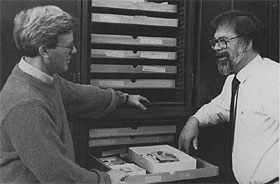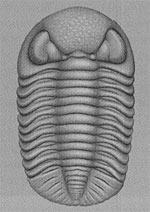Interview: Niles Eldredge

Dr. Niles Eldredge is a paleontologist at the American Museum of Natural History in New York City, where he is a curator (and the chairman) of the Department of Invertebrates. In addition to his research and responsibilities at the museum, Dr. Eldredge has authored 11 books on the subject of evolutionary theory.
Dr. Eldredge is perhaps best known for his work on the tempo of evolution. One view of evolution emphasizes gradualism: the idea that minute evolutionary changes accumulate over vast spans of time to produce evolution on a grander scale. This implies that the fossil record should provide evidence of new species being linked to their ancestral species though a succession of intermediate fossil forms. In most cases, however, new species appear in the fossil record rather abruptly and then undergo little obvious change for the rest of their existence. Niles Eldredge interprets this feature of the fossil record as evidence that evolution occurs primarily in fits and starts rather than by a smooth continuum of minute changes.
Along with Steven Stanley of Johns Hopkins University and Stephen Jay Gould of Harvard, Dr. Eldredge is one of the principal architects of a theory of evolution known as punctuated equilibrium. Its central point is that most anatomical change is compressed into bursts of evolution that punctuate longer periods of relative stasis.
In this interview, Dr. Eldredge discusses his work at the museum, his writing, and his thoughts on current issues in evolutionary biology.
Dr. Eldredge, could you tell us about your own education and how your interest in science and paleontology developed?
My interest in natural history and dinosaurs was like that of most kids who grew up in the 1950s. A really important thing happened to me when I went to college at Columbia University in New York City. I took a paleontology course in my junior year, and I became very deeply involved with it. I think I had decided to become an academic almost before I picked a field, and then I got swept away with circumstance, finding a field very quickly for which I developed a real, intense love: invertebrate fossils. There are literally trillions of them out there, so it looked like a wonderful opportunity.
Most academics opt for university careers. How is it that you decided on a museum?
It wasn't really a matter of seeking out a museum environment or museum career. I came up under a program that we still have, part American Museum of Natural History, part Columbia University. At that time, the museum curators were simultaneously full faculty members as opposed to being adjuncts, the way we are now. So it was natural for me to join the faculty at Columbia at the same time I joined the museum. Of course, there are certain aspects of university life that you don't have here: the extensive teaching, for instance. Here you teach if and when you want. From the point of view of scientific research, the great part about this museum is that it is first and foremost a research institute. Many people have left university environments to come here because of this emphasis on research.
Are there other advantages to a museum appointment besides the extra time you have for research?
It gives you the opportunity for closer contact with the public through exhibitions and educational programs. For example, I like to go on the museum's educational cruises and hang over the ship's rail and have a beer with people and talk about fossils, evolution, and so on, and admit that I don't always know all the answers.
What does it actually mean to be a curator of invertebrates?
The first obligation of a curator is original scientific research. Service to the museum comes next, and in a collection-based department such as ours, that means maintaining the collections. The museum is really a library of natural history items. Curators have a mission to maintain these collections as a sort of sacred public trust. You have to have a commitment to the importance of the work that revolves around the collections before you work in a museum. Computerizing the collections is another task. We have an online collection inventory that people can call from all over the country. The scientific staff is also responsible for the veracity of the content of the exhibits. There are normal administrative duties, teaching at institutions in the vicinity, giving lectures, and so on. And of course, field work takes us out of the museum.

The museum is setting up a laboratory for molecular systematics. How do you think molecular biology will influence modern evolutionary biology?
In several ways. Molecular biology gives us insight into things we can't see with our old technology, and this potential is very exciting. What is even more interesting to me is to see molecular biologists who don't want to be just molecular biologists, but are thinking, "This has to have some evolutionary implications." It is quite obvious already from gene-sequencing data that there are greater similarities in the sequences between organisms that share a relatively recent common ancestor. And comparisons of DNA can be used to assess more distant relationships. The reason I am particularly interested in seeing this work done in our department is that invertebrates were already differentiated into the major phyla about 600 million years ago. I am hoping that the data for highly conserved sequences of DNA will help us analyze the evolutionary relationships between the major groups of invertebrates.
Are there opportunities for undergraduates or new graduates to intern in natural history museums?
We have had a graduate/undergraduate research program; I started here in that program. It is not restricted to summer, though it is used mostly during the summer. In addition, the museum is now giving predoctoral fellowships. It is incumbent upon us to train our successors. We have to become even more dedicated to an educational approach than we have been.
Dr. Eldredge, you have written several books for nonscientists. What moves you to write for the general audience?
One of the first books that I wrote for the general public, in 1982, was The Monkey Business. I got drawn into that because I found myself unwittingly being used by the creationism movement. I had given an interview in which I was attempting to say that I thought it would be appropriate for a high school biology teacher getting into evolution to acknowledge that creationist beliefs exist, that students may have such religious beliefs but that they would be expected nonetheless to study what science says about evolution. My position was misrepresented as supporting the teaching of creationism in high schools. I felt embarrassed and used. I got mad and wrote a little article for the New Republic and then later expanded it into a book. As I was doing this, I found out that I had to be able to explain to anybody what the basics of evolution were, and that turned out to not be as easy as I had thought. I also realized that a lot of my colleagues were in the same boat, and I thought that it was incumbent upon all of us to try to address this communication problem.
When you write for the general public, you can write for intelligent people who don't share all the special training in a field and still write things that are very interesting and from which readers can learn. Another side of this is that you can take your message to the intellectual world by spreading it even more widely. Several times in my career I have had colleagues point to a general piece of writing and say, "That is the first time I have ever really understood that point." The midground, as I see it, is the fact that I am always writing for students.
There has been a revival of interest in paleontology in the past ten years or so. How do you account for this?
That is an intriguing question, and I don't have a pat answer. Traditionally, paleontologists have been content to describe the contents, the furniture, of the world and have not been too concerned about cause. They write about what has happened and pay less attention to how or why it happened. In the seventies they started talking about causal relationships rather than simply describing fossils. In addition, they didn't just take a body of biological theory on faith and use it to explain the fossil data; they looked at the fossil data and asked, "What does this tell us about the theory?" This made paleontology more exciting.
By the late seventies there were rumblings from the paleontological community about the nature of the evolutionary process, and biologists and geneticists were beginning to take notice. At the same time, creationism was resurfacing, and the creationists were quoting the new theory called "punctuated equilibrium." We "Punc Eckers"—Stephen Jay Gould, Steven Stanley, myself, and a number of other people—seemed to give aid and succor to the enemy by daring to criticize the Darwinian message, when in fact we were turning out to be some of the more vocal, more visible anticreationists. So that brought paleontologists back into view. And then there is the phenomenon of Stephen Jay Gould himself, an exceptionally popular writer for the general audience. More than any other person, he probably symbolizes the revival of paleontology in the minds of people.
You mentioned punctuated equilibrium. Can you describe the theory?
There are really two components to the basic theory, neither one of which was terribly original. First is how we interpret the fundamental observation that there are few good examples of slow, steady, gradual transformation within species in the fossil record through time. Darwin attributed this lack of evidence for gradual transformation to the fact that paleontology was a very young science in his time and the fossil record was incomplete. But a hundred years later there still weren't many satisfying examples of gradual transformation. The theory of punctuated equilibrium takes this observation at face value and accounts for the rarity of gradual transformation by emphasizing stability in the history of each species. The morphology of a species changes little after that species becomes established.
Second, the theory implies that most anatomical change is compressed into the relatively short time it takes for speciation to occur. Of course, the changes aren't sudden from a genetics point of view; we are talking about 5,000 to 50,000 years, ample time for the kinds of changes we are talking about. But it is sudden vis-à-vis the typical long histories in the fossil record, where individual species hardly change at all. So most anatomical change in the fossil record seems to be concentrated, to occur in relatively brief bursts punctuating longer periods of relative stability.

Doesn't this idea that stability prevails in the history of a species challenge conventional Darwinism?
Darwin argued that evolution was an inevitability, and he was basically right. But among many of Darwin's followers the feeling grew that since the environment is always changing, it follows that evolution within species occurs continuously, that no species is going to remain the same. People are now beginning to see that what often happens when the environment changes is that species track suitable habitats. I mean, adaptations do change. There is no question about that, and I am sure they change, at least in part, in response to changing environments. But what usually happens is that organisms relocate—even trees, via mechanisms that disperse seeds. That is what happened during the Ice Ages in North America. There wasn't a tremendous amount of evolutionary change going on, but the geographic ranges of species changed. If it is not possible to relocate to a tolerable environment, then extinction is the next most likely thing. The least likely thing is for a species to become modified in the face of a changing habitat. I think that evolution does basically represent a match between organisms and environment. I just think that it is a tremendously conservative process most of the time.
Then how do new species originate?
I agree with Ernst Mayr and others that speciation is first and foremost the establishment of a new reproductive community from an old one. If a small population is split off from a larger parental species at the periphery of the species range, you are probably looking at organisms that are adapted to the extremes of environmental conditions that the species can tolerate. Populations living out there at the margins of the species' range are already adapted to some extent to a different kind of environment. If that population ever becomes completely isolated and no longer able to interbreed with other populations, adaptation to the local environment can be solidified. By setting up reproductive isolation, what you are really doing is giving a fledgling population a chance to have its own history; it is not going to be sharing genes anymore with the parental species. It is sink-or-swim time. Most probably sink and suffer early extinction. But if an isolated population survives and establishes a new species, most of the anatomical change involved probably occurs relatively rapidly.
Is there evidence for punctuated equilibrium in human evolution?
Humans are really tricky. It is easier to see punctuation in lineages with a lot of adaptive anatomical specialization: Such lineages tend to be rather short-lived in the fossil record, and typically they show a lot of speciation.
Hominids are a funny mixture, adaptively speaking. We are very specialized because of our culture, and our big brains are obvious anatomical features that are tied in with our cultural adaptations. On the other hand, we are generalists in how we cope with environments; in fact, our cultural successes sort of enhance our ecological generalness. So the fossil record on hominids is very strange. Some anthropologists claim that statistically there is no significant difference between the brain size of the earliest Homo erectus and the latest erectus. The picture you get is of a successful species that runs from southern Africa all the way to Java; that is variable, particularly culturally; but that has persisted for about 1.5 million years without any statistically significant change in brain size. Other people don't agree with this interpretation. Human beings are not the best case for punctuated equilibrium.
In your book Life Pulse, you wrote that if Darwin's expectation of gradual progressive change does not emerge from the fossil record, the main signal in life's history is extinction. Would you please explain?
I have the feeling now that if extinction hadn't chewed up the ecological fabric of life periodically, nothing much would have happened. You get some background speciation going on, but nothing really dramatic. For example, if you look at the marine forms of the Paleozoic era, you see that during several periods of time the ecosystems are fairly well established. Certain communities of species keep moving around geographically because the environment keeps changing, but pretty much the same species are forming the same sorts of communities over and over again through millions of years. Then all of a sudden the whole community disappears and you get another community with new species. And the greater the precipitating disaster, the greater the difference between the old and new forms. Apparently, there has to be a relatively severe ecosystem collapse before anything truly new accumulates. And that is what evolutionary history really is like.

Some of these upheavals in ecosystems have apparently been global. What could cause such mass extinctions?
Speculation about that is rife. A lot of the older ideas about extinctions were geared toward certain groups of organisms. Dinosaurs, for instance. They didn't take into account the fact that extinctions are ecosystem-wide and that very often marine, freshwater, and terrestrial environments are affected simultaneously. More effective theories take account of all these things.
I am well aware of the impact hypothesis: asteroids hitting the Earth. I am prepared to believe that not only do asteroids hit the Earth regularly, but that when they do, they can potentially play tremendous hob with life. On the other hand, extinction seems to be so much a part of the rhythm of things that I can't believe it always has the same extraterrestrial cause. As a general mechanism, I think we have to look at the threshold effects that you get from a linear modification of the climate. A climatic change, which could be as little as a drop of 1°-2°C in mean annual temperature, is going to have a tremendous effect on the distribution of organisms. Some organisms will be able to adjust much better than others. It is a catastrophe only in retrospect: These changes usually take place over tens of thousands if not half a million years. People are concerned about how our own influence on the climate might affect the rest of life. We are clearly worried that something major could happen, particularly with our own negative intervention. So, it is perfectly possible to imagine severe ecological reorganizations occurring without a fireball coming in from space.
Isn't the view that mass extinction is an important force in evolution at odds with some people's impression of evolution as a progressive improvement of life on Earth?
I think our tendency to view evolution as progress stems from Darwin's time, when change could be accepted as a real phenomenon in nature only if it was viewed as improvement and progress. I don't know if we would call a cheetah species that is slightly faster—running than the mid-Pleistocene species progress, but if your criterion is speed, it is improvement. The really complex adaptations—the disguising body forms of walking sticks (insects) are a good example—need a lot of time, a number of speciations, to accumulate. You could construe that as a form of progress.
But extinction due to an environmental crisis has nothing to do with how well an organism has adapted to its normal living conditions; it is just bad luck who goes and who doesn't go. Dinosaurs are a great example. Their extinction doesn't mean that they had come to an evolutionary dead end (although dinosaurs do seem to have been on the decline before they finally disappeared). They lived quite successfully for 150 or 175 million years, and if they hadn't had some environmental bad luck, they might still be here now and, of course, we wouldn't. There is nothing inevitable in the system that human beings would emerge. And that is where the importance of extinction really is: it reshuffles the deck.
Recently a student asked me, "If extinctions have been such an important theme in the history of life, why is everybody so upset about endangered species?" How would you answer that?
I do not see evolution as something that is intrinsically good. We are part of the biota that is now threatened with extinction, and we have every reason to resist. It is easy to take a dispassionate view about other extinctions—the dinosaurs went; they were great but they went—because we weren't here. But we don't want someone down the road saying about us, "They were fine in their time." I think also that the biota is interconnected enough that severe degradations, severe extinctions of other species, will seriously affect human life. There is no question about that. Finally, the conditions that are eliminating other species are also very directly threatening our own existence. That is perhaps even more to the point. For a variety of complex reasons, our future is very much going to be mirrored in the fates of other species around us. So if we care about our own future, we ought to care about the fates of other species.
©2005 Pearson Education, Inc., publishing as Benjamin Cummings